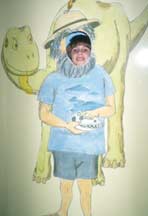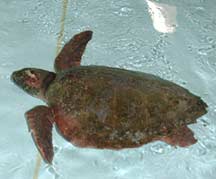|
|
In This Week's Issue:
Smarter Than the Average Bear: Maryland’s Black Bear Response Team
When Harry Spiker discovered the rump of a bear hovering over heaping trashcans in his backyard last summer, he was sheepish.
Spiker, bear biologist for the Department of Natural Resources and member of Maryland’s Black Bear Response Team, was guilty of the very act he warns residents about: leaving trash outside in a bear-infested region. His Labrador chased the bear up a nearby tree, but Spiker probably could have dealt with the marauder on his own, with the training and equipment he has for just this sort of problem.
 |
Black Bear Response Team member Terri DeWitt tags a bear cub in Western Maryland.
photo by Lisa Gutierrez, courtesy of DNR |
Maryland has a Black Bear Response Team because — like most every other part of the North American continent — we have bears. From the lush forests of Mexico and Florida all the way up to the frozen tundra of Alaska, some 750,000 black bears make their dens.
The hilly forests of Western Maryland are no exception. Campers, hikers and especially residents of the region all have a great chance of running into bears: on the trail, in a backyard or even along the road. So it might come as a comfort to know that there is a team of dedicated professionals, including Spiker, trained to protect Maryland residents from these intimidatingly robust creatures, who are gentle by nature but unpredictable nonetheless.
The Black Bear Response Team that has kept Marylanders safe from bears ’round the clock for five years has just been named Employee of the Year by the Maryland Wildlife Advisory Commission.
Team members are highly trained in firearms, chemical immobilization equipment, bear-behavior modification and bear-aversion tactics, said Jim Mullan, regional wildlife manager for the Department of Natural Resources.
“The Black Bear Response Plan clearly spells out the strategy,” Mullan said. Team members “must assess the severity of the situation or potential situation; if the situation is threatening, they can use firearms.”
The seven members of the Black Bear Response Team are responsible for bear emergencies in Garrett and Allegany counties, the two most bear-populated areas in the state. They are on duty every day, all day long from April through October, the highest period of bear activity. Last year, the team responded to some 20 emergencies, which is about nine percent of the total bear-related calls in the season.
We have all heard a story or two of gruesome bear attacks that have left people stranded up trees or worse. These horrific tales have left the animals with a reputation that, for the most part, is unmerited. Black bears are generally docile creatures that only attack in rare situations, usually involving a mother protecting her cubs.
Mullan said that no bears have attacked humans in Maryland and about half of the calls for the Response Team have been nuisance-related problems, such as bears digging through trash cans.
In these less-threatening cases, the response plan involves scaring the bears away through loud noisemakers or painful stings, with such equipment as pepper spray or rubber slugs. The team tries not to relocate the animals after an incident, as a bear’s sense of direction is extremely advanced, and they will often return to the scene.
So when you go camping or traveling in the western counties of Maryland, black bears may be nearby — but the Response Team is, too.
— Sarah Williams
back to the top
No Place Like Home: Chesapeake Children’s Museum Reopens
The turtles are in the tank. “Stuffee” is out of the closet. After more than two years in boxes and bags, the Chesapeake Children’s Museum is opening its doors to the public.
 |
Interactive displays, like the Junior Paleontologist offer hands-on learning for kids of all ages at the newly reopened Chesapeake Children’s Musem.
photo by Martha Blume
|
Director and child development specialist Debbie Wood has been waiting a long time for this project to come to its fruition. “It was in my head when my kids were little,” she says. “I had to wait until they got bigger. Then I did my Ph.D. Then it was time for a new project.”
The museum was her brainchild and her creation. With the help of many volunteers — mostly moms who brought their children through its doors to awaken their curiosity, to meet other moms and to contribute to the community — the museum has been in operation since 1992, but never in a permanent home.
After years at Festival at Riva shopping center (its lease expired in February 2000), the Museum moved to its new space at the old WYRE radio station at 25 Silopanna Road. But its doors remained closed until the building could be brought up to code and the necessary permits obtained from the city. That involved a lot of volunteer hours and donations and plenty of waiting.
It’s been a long haul. During its closure, the museum continued to function through the MEOW bus, Museum Education On Wheels, which rolls around Annapolis visiting children in public housing communities; and through off-site programs, such as Come Together, Annapolis! at the City Dock.
Still, there’s no place like home.
Looking around the new site, it’s clear it was worth the wait. Every room beckons a burst of children’s energy and imagination.
There’s Center Stage, the purple room, where kids can dress up and put on plays for their moms and dads. Body Works is a dentist’s office, where mom and dad are the patients. “It helps a child gain a measure of control and resolve his or her fears,” says Wood. Stuffee, the seven-foot, squeezable human body with removable organs, lives here too.
Dion the diamondback, Reggie the red-eared slider and Franklin the snapping turtle live in Bay Window, with terrariums and aquariums providing windows to life in the Chesapeake Bay. The Chesapeake marsh comes to life on these walls in Barbara Love’s murals. And everywhere are intergenerational considerations, like the dock and ramp in Bay Window.
 |
Artist Barbara Love, above, added murals to bring to life the Chesapeake marsh.photo by Martha Blume
|
“Toddlers love to crawl and walk on angles,” Wood explains. “When I go to a museum, I ask myself ‘Are the adults bored? Is the baby bored?’ If the answer is ‘yes,’ the exhibit isn’t perfect.”
In Express Yourself, kids can do just that with paints and sinks and no fear of making a mess. Wood describes it as “help yourself art.” Big chairs and little chairs make it a place where kids and parents can come to work on projects together.
Around the World features a Colombia exhibit with a Colombian home, toys and clothes to wear, a live iguana, a rainforest and puppets. Alexandra Gilliland, an Arnold Senior Girl Scout, earned her Gold Award for the murals depicting the Colombian rainforest.
Down the stairs in Lily Pad there are frogs and toads by Gillian Connor on the walls and real toads in a terrarium. There is room for folk dancing and creative movement, sinks for Toddl-art, a science workspace, computers and books for study and home-school projects.
Wood plans to open the doors on November 16, with a Grand Re-Opening Celebration for donors, volunteers and city officials. Two Girl Scout troops have programs scheduled for that day as well. The Museum is open to the public from 10am to 4pm every day but Wednesday. Wednesdays and other days after 4pm is time for groups and scheduled programs.
Information? 410/990-1993 • www.theccm.org.
— Martha Blume
back to the top
Ms Senior Maryland Lonnie Stein
 Lonnie Stein prepares for this pageant like thousands of other contestants do: thoroughly. Her song and dance routine is rehearsed to perfection. Her gown is flawless. Question-and-answer sessions are practiced in painstaking detail. So what makes Lonnie Stein different from any regular Miss America contestant? Lonnie Stein prepares for this pageant like thousands of other contestants do: thoroughly. Her song and dance routine is rehearsed to perfection. Her gown is flawless. Question-and-answer sessions are practiced in painstaking detail. So what makes Lonnie Stein different from any regular Miss America contestant?
About five decades.
Maryland’s Ms Senior America, Stein is now preparing for her debut on the big stage when she competes in the Ms Senior America pageant this weekend.
Stein says she’s ready. “Trying to get everything down to perfection is somewhat wearing on my nerves,” she allows. “But you forget about inhibitions once you are on stage.”
The Ms Senior America pageant has been around for a few decades, too. In its 30th year, the pageant is a competition of women over 60, focusing on women’s inner beauty and strengths. Judging is based on several categories, including an interview, inner beauty, formalwear and talent. This year, the states’ senior Ms Americas compete in Biloxi, Mississippi.
It’s a competition in which Stein devoutly believes. She sees senior women as models for the younger generations, with the Ms Senior America contest an exceptional presentation of that message.
“Senior women have so much to offer,” she says. “They serve as good representatives of age, of talents, showing younger people this is what you can become.”
Still, the 74-year-old resident of Edgewater never expected to be crowned Ms Senior Maryland. She didn’t even expect to compete. Her goal was to become the unpaid director of Ms Maryland Senior America, promoting the event around the state. Participating in this year’s state competition, held in August, was her ticket to the job. As director of Ms Maryland Senior America competition, Stein hopes to hold the next state pageant in May, 2003.
Entering this year’s contest at the last minute, Stein was lucky to have her gown and act already prepared. “I was very flattered when I won,” she says.
Don’t let her modesty fool you; entering pageants is not new for this former model. Her first competition was the Miss Cotton Capital of the U.S. pageant, in which she placed in the top 10. While working as a tour broker and travel agent, she continued to participate, involving herself with many pageants since.
Hers is a classic story fit for Hollywood. After graduating from high school in Birmingham, Alabama, Stein moved to Memphis to become a model. She worked as a runway and photography model, also doing radio and television work and a lot of community theater. On a trip to Hawaii, she met her future husband, who was stationed with the Navy. They wed 38 years ago.
Stein even resembles a movie star, with silken white hair as flawless as a snowy morning and a dazzling smile that lights up a room. Though she’s lived away from the South for decades, she still has a trace of a dainty Alabama accent and the mannerisms of Southern gentry.
Southern charm has probably helped Stein snag her many roles in regional community theater productions. Her devotion for theater began when she was five and remains a passion. “Acting is something that is very dear to me,” she said.
She’ll be auditioning for Colonial Players’ spring production of Pippen as Ms Maryland Senior America.
This week, Stein is in Biloxi, where she will perform her rendition of “If My Friends Could See Me Now,” interview with a panel of judges and present herself in her gown.
“It’s not the kind of beauty contest that you see usually,” she says. “It’s really about the beauty inside of us, what we have accomplished, our talents, philosophies, how we handle an interview.”
This weekend, our neighbor from Edgewater just might have the combination it takes to become the next Ms Senior America.
— Sarah Williams
back to the top
A Story of Five Turtles: Four Deaths, One Happy Middle
The November week when leaves flutter their farewells brings us one leave-taking that takes the bitter out of the season’s bittersweet flavor. As this paper hits the stands, our environment grows one turtle richer.
We’re talking no backyard turtle but a loggerhead that — with good luck and the right environmental conditions — may grow into a 350-pound giant of the sea and live as long as the most aged humans.
But this teenager’s odds on seeing a century are low. Many of the world’s turtles are threatened, even to Maryland’s endangered bog turtle and our common box turtles. Most of the threats are manmade, from habitat loss and pet trade in the developed world to by human appetites in the Third World.
 |
After a run-in with a boat propeller, this loggerhead was rescued and rehabilitated at the National Aquarium.
photo by National Aquarium volunteer Pat Venturino
|
For sea turtles like this one, competition is rising in all sorts of human forms, from boat propellers to well-lit nights. The increasingly developed mid-Atlantic and Florida coasts are major nesting sites for loggerheads, which are one of the largest of sea turtles. Most of their time is spent in warm waters around the world, where they swim and forage. But females — as this one is believed to be — dig nests on shore, where lights can disorient them and the miniatures that hatch from the eggs they lay.
Propellers have given this youngster a story to tell.
She was struck by a propeller, whose blades not only bruised her skull and damaged her right eye but broke her shell. Gas built up in her body cavity, impeding her swimming and preventing her from diving for food. As with most stranded animals, this turtle suffered digestive problems and dehydration.
Four other sea turtles stranded this summer died before the aquarium team could help them.
This one was luckier. First, a boater in Delaware came on it in shallow water, noticing its wounds. Then the National Aquarium in Baltimore’s Marine Animal Rescue Program got to Bauer’s Beach in time.
From July to November, the wounded turtle recuperated in the aquarium hospital’s 100,000 gallon pool, getting sophisticated treatment humans endure — from physical inspection to X-rays, blood work, endoscopy and even an MRI at Johns Hopkins.
“We’re very lucky to be where we are and get the cooperation of John Hopkins,” said team member Cindi Perry. “The technicians and doctors there usually see humans, but they’re more than willing to help us out.”
On a diet of romaine lettuce, herring and squid purchased from local restaurant suppliers and blue crab fresh from local seafood markets, the recuperating turtle gained 20 pounds, weighing in at 100 at its exit physical.
She passed that physical and, on November 14, was hoisted from her pool, packed into a foam-padded wood crate and loaded in a Chevy Suburban headed for the ocean. Rescue teammates kept her comfortable with spritzes from a spray bottle as the party headed for Charleston, South Carolina. There, with the help of staff from the South Carolina Aquarium, the turtle returned home.
But the moral of her story, rescue worker Perry advises, relates to us. “These animals tell the story of increased interaction with humans. The more time humans spend on the water, the more rescues we make. People need to be aware and very respectful in the water we share with countless animals.”
— SOM
back to the top
Way Downstream
In Chesapeake Bay, aerial surveys have detected the biggest increase of Bay grasses since 1983, Bay Journal reports. Too bad humans can’t take credit for this success. The enduring drought prevented runoff of nutrients and pollution that normally kill budding submerged aquatic vegetation …
In the Magothy River, you can buy your own island for a cool $1.75 million. Owners of Dobbins Island, which has eroded down to less than half of its original 18 acres, is looking for a well-to-do buyer, perhaps one needing a helicopter pad, the Washington Post reports …
In Virginia, Ed Lewis, a diver for the Chesapeake Police Department who has pulled 40 bodies from the water, is spearheading a drive to build a memorial for Virginia watermen who die on the job, according to the Virginian-Pilot. Maryland has such a memorial for our fallen watermen at a park on Tilghman Island.
Our Creature Feature comes from Britain, where conservationists are fighting to save the U.K.’s biggest fish. Basking sharks, which can tip the scales at seven tons and live to be 100 years old, are being slaughtered for their 30-foot-high dorsal fins. The fins are good in soup and sold as medicines and aphrodisiacs in Asia.
Preservationists want an end to the killing of these harmless, plankton-eating creatures when the Convention on International Trade in Endangered Species meets next week. “These gentle
giants of the sea need protection,” said Clive James, director of Shark Trust.
back to the top
Copyright 2002
Bay Weekly
|